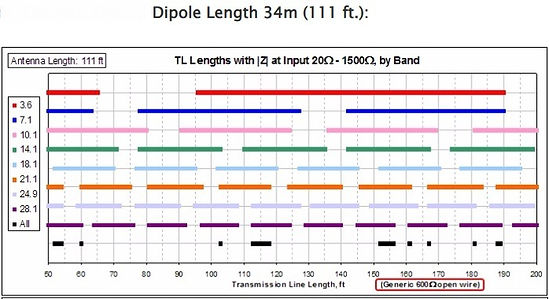My antennae
Here are the antennas I use at the moment. See also under the remotestation tab. At the bottom of the page there are also some tips and links for those of you who like to build your own antennas.

The beam is a Hygain Explorer and it has the bands 30m, 20m, 15m and 10m. Above it a warcbands dipole and at the top a vertical from Diamond for 2m and 70cm. It's all mounted on a sled so I can lower the antennas to the top for easier servicing.

Here is the rotor that I turn the antennas with. It sits on the floor in the attic and I built it from a Permobil engine, two gearboxes and chain drive.
The rotor is operated with a control box from CDE.

I use this antenna for the 40m and 80m bands.
The upper part for 80m is slightly shortened and thus adapted for the attachment points I have access to but performance and bandwidth is basically equivalent to a full length dipole.
The coils inductance is 30 Mikrohenry, read more about the coils further
down the page.

Antenna analysis 80m
.png)
Antenna analysis 40m

Here is a picture of my 80m vertical that I have mounted on my boathouse.
The antenna has a coil in the middle and uses the tin roof of the boat house as a ground plane. If you don't have access to the metal roof or the like, it works just as well with counterweight ropes.
Antennas for smaller gardens

Shortened antenna for the 80m band that works well.
This antenna is much shorter and thus narrower, but works to tune with the radio's internal tuner over the entire band with good results.
The coils are of the same construction as on my wire antenna for 80m and 40m further up the side. They are wound on 50 mm electrician's pipe.
By wrapping with RK el. FK1.5mm2 automatically gets a "pitch" of 1:2.
45 turns gives the desired 30uH.
A 140 mm pipe length is used for the winding itself, but a 160 mm pipe is used to accommodate the reliefs. The antenna is previously posted by SM4FPD, thanks Roy for a good antenna for small spaces.

Really good Windom antenna for all bands from 40m to 10m including the Warc bands.
Works very well and goes on all bands including the warc bands without too high SWR.
Can be tuned with good results on 6m but works poorly on 80m.
Avoid running the coax parallel to the antenna wires and preferably use a -
RF-choke or similar to prevent RF to the shack, which can be a problem with Windom antennas.
I myself have some tube ferrites on the coax just below the balun and have never noticed any RF in the shack.
I bought this antenna but it is easy to build yourself.
The antenna is designed and sold by Nigel Booth - M0CVO
Step fed

Min stegmatade dipol på min remoteplats.
Troligen Sveriges dyraste stege då min dotter som monterade ihop den fick 4 kronor för varje stegpinne :-)

Här kan man se de låga förlusterna vid en stegmatad antenn.
Kan man bara stämma av den så är furlusterna försvinnade små.

Längkarta på dipol och steglängder

En linkkopplad Anneke-tuner avsedd för stegmatning.

Vill man slippa tuner går det bra att koppla in olika steglängder för att hamna rätt.
Baluns and chokes
Here, 2 baluns are suitable for several of the antennas on the side. They are wound on the toroid core Amidon FT 240-43 which is easy to find for purchase._cc781905-5cde-3194-bb3b-136bad5cf5 50d_Maxw power ca. If you need higher power endurance, you stack two cores, maximum power 1000w.


If you want to read more about baluns and how you make them, visit Wolfgang Wippermann's (SK) website. He was a guru on baluns and on the website he shares the knowledge of building well-functioning baluns.
https://www.wolfgang-wippermann.de/
Här på VK6YSF hemsida hittar du också bra beskrivningar hur du bygger baluner.
https://vk6ysf.com/balun_choke_balun_low_vhf.htm
You can build an RF choke by wrapping the coax around a plastic tube, a so-called "uggly balun".


The coax wound around a toroid core provides a wider bandwidth RF-Choke.
You can see the number of turns and frame/toroid here.
Antennmyter inom amatörradion
Bertil Lindqvist, SM6ENG, har funderat mycket över myterna inom amatörradiovärlden. Här har han sammanställt och kommenterat ett antal av de myter och missförstånd han tycker är vanligast förekommande.
Även Bengt Lundgren, SM6APQ (Silent key) är med som författare.
Sidorna är hämtade från ESR med deras godkännande.
Besök gärna deras hemsida som innehåller mycket matnyttigt för den teknikintresserade amatören.
- Om vi har en sändare som ger 100W uteffekt och
ståendevågförhållandet (SVF) är 3:1 kommer det då ut
75W i antennen?
- Jordning

